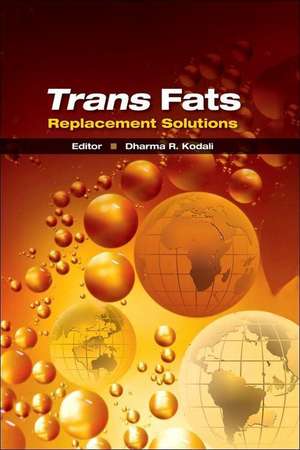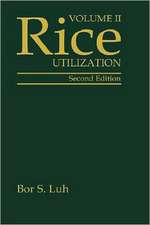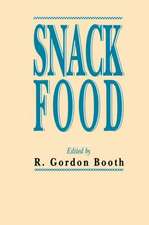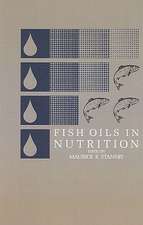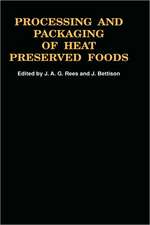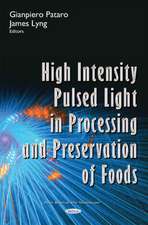Trans Fats Replacement Solutions
Editat de Dharma R. Kodalien Limba Engleză Paperback – 18 aug 2016
- Includes details on how trans fats became a part of our food chain, why they remain a health issue, and what replacement solutions exist
- Offers in-depth analysis of the structure, properties, and functionality of fats and oils
- Describes trans fats regulations and scenarios in different geographies around the world
Preț: 587.54 lei
Preț vechi: 645.65 lei
-9% Nou
Puncte Express: 881
Preț estimativ în valută:
112.43€ • 117.68$ • 93.57£
112.43€ • 117.68$ • 93.57£
Carte tipărită la comandă
Livrare economică 24 martie-07 aprilie
Preluare comenzi: 021 569.72.76
Specificații
ISBN-13: 9780128103807
ISBN-10: 0128103809
Pagini: 468
Dimensiuni: 152 x 229 mm
Greutate: 0.62 kg
Editura: ELSEVIER SCIENCE
ISBN-10: 0128103809
Pagini: 468
Dimensiuni: 152 x 229 mm
Greutate: 0.62 kg
Editura: ELSEVIER SCIENCE
Cuprins
- Preface
- List of Abbreviations
- Chapter 1: Trans Fats: Health, Chemistry, Functionality, and Potential Replacement Solutions
- Introduction
- Health Effects of Trans Fats
- Structure, Properties, and Functionality of TAGs
- Functional Need for Solid Fat in Food Products
- Trans Fats Replacement Strategies
- Designer Fats
- Ideal Designer Fats for Solid Fat Applications
- Summary
- Acknowledgments
- Chapter 2: Natural versus Industrial Trans Fatty Acids
- Natural versus Industrial Trans Fats: Basic Hypothesis and Background
- Natural versus Industrial Trans Fatty Acids: Chemistry and Dietary Sources
- Analytical Considerations and Biomarkers of Intake
- Impact of Natural and Industrial TFAs on Blood Lipid Profile and Coronary Heart Disease Risk
- Public Health Implications
- Chapter 3: FDA Food Labeling Regulations for Trans Fat
- Introduction
- Trans Fat in Nutrition Facts
- Nutrient Content Claims
- Health Claims
- Latest Developments in Trans Fats Regulations
- Similar International Trans Fat Labeling Regulations
- Chapter 4: Nutritional Aspects of Trans Fatty Acids
- Introduction
- Characteristics of Trans Fatty Acids
- Intake of Trans Fatty Acids
- Trans Fatty Acids and Cholesterol
- Trans Fatty Acids and Cardiovascular Disease
- Trans Fatty Acids and Adiposity and Weight Management
- Trans Fatty Acids and Diabetes and Insulin Resistance
- Trans Fatty Acids and Cancer
- Reduction of Intake of Trans Fatty Acids
- Conclusion
- Chapter 5: Application of Gas Chromatography and Infrared Spectroscopy for the Determination of the Total Trans Fatty Acid, Saturated Fatty Acid, Monounsaturated Fatty Acid, and Polyunsaturated Fatty Acid Contents in Edible Fats and Oils
- Introduction
- Capillary Gas Chromatography
- Mid-Infrared Spectroscopy
- Near-Infrared Spectroscopy
- Conclusions
- Chapter 6: Processing Solutions: Fractionation and Blended Oils
- Introduction
- Sources of Solid Fat Alternatives for Partially Hydrogenated Vegetable Oils
- Palm Oil: The Most Versatile Solution to Trans Fat Reduction in Processed Foods
- Component Blending to Match PHVO High Trans Shortenings and Fats
- Formulating Palm Oil and Its Fractions for a Diverse Range of Functional Products
- Summary and Conclusions
- Chapter 7: High-Oleic Oils and Their Uses for Trans Fats Replacement
- Introduction
- Compositions and Properties
- Chapter 8: Latest Developments in Chemical and Enzymatic Interesterification for Commodity Oils and Specialty Fats
- Introduction
- Random Interesterification for Commodity Oils
- Specific Enzymatic Interesterification for Specialty Fat Products
- Conclusions
- Chapter 9: Enzymatic Interesterification
- Introduction
- Reaction Mechanism
- Monitoring Method for the Process of Lipase-Catalyzed Interesterification Degree
- Process Development for Lipase-Catalyzed Interesterification
- Characterization of Lipase-Catalyzed Interesterified Fat
- Crystal Microstructure
- Chapter 10: Structured Emulsions and Edible Oleogels as Solutions to Trans Fat
- 1.1 Introduction and Recent Progress in Regard to Trans Fat Reduction
- Effects of Specific Fatty Acids on Our Cardiovascular Health
- Structured Emulsions Using Monoglycerides
- Organogels
- Waxes and Wax Organogels
- Oleogels Made Using 12-Hydroxystearic Acid
- Ethylcellulose (Polymer) Oleogels
- Imaging the Polymer Network Structure of Ethylcellulose Oleogels
- Production Considerations and Food Applications of Ethylcellulose Oleogels
- Using Oleogels for Nutraceutical Delivery or Encapsulation
- Phytosterol–Oryzanol Mixtures for Organogelation Purposes
- Conclusion
- Chapter 11: Trans Fats Replacement Solutions for Frying and Baking Applications, Shortenings, Margarines, and Spreads
- Introduction
- Blending as Zero Trans Options
- Trait Modified Oils as Trans Fat Replacements
- Case Studies on Trans Reformulation in Fast Food Chains and Laboratory Frying (Trait-Modified Oils)
- Baking
- Palm-Based Baking Shortenings
- Troubleshooting Trans-Free Frying and Baking
- Zero-Trans Margarines and Spreads
- Conclusion
- Chapter 12: Trans Fats Replacement Solutions in North America
- Introduction
- Consumption Patterns: Effect of Trans Fat Labeling
- Food Service Applications and Products
- Trans Fat Regulation in Canada
- Commercial Trans Fat Replacements
- Innovations in Trans Fat Replacements in the Food Service Sector
- Other Trans Fat Alternatives
- New Low-Saturate/No-Trans, Omega-3-Enriched Oils in the Commercial Pipeline
- Margarines and Spreads
- Chapter 13: Trans Fats Replacement Solutions in Europe
- Introduction
- TFA Intake in Europe
- TFA in Foods in Europe
- Trans Fat Regulations in Europe
- Why Industrial TFAs Were Used in Food Products in Europe
- Low Trans Partial Hydrogenation
- Elimination of Partially Hydrogenated Vegetable Oils as Structurants from Fat-Continuous Margarines and Spreads
- Replacement of Partially Hydrogenated Vegetable Oil as a Cocoa Butter Alternative
- Replacement of Partially Hydrogenated Vegetable Oil in Stable Frying Oils
- Conclusion
- Chapter 14: Trans Fats Replacement Solutions in South America
- The Hydrogenation Process in Brazil and Argentina
- Trans Fat Free Americas
- Regulation of Trans Fats in Brazil and Argentina and Intake Recommendation
- Trans Fatty Acid Content of Brazilian and Argentinean Foods Before and After Mandatory Trans Fat Labeling
- Alternatives to Reduce Trans Fat in Foods
- Chapter 15: Trans Fats Replacement Solutions in China
- Introduction
- Labeling and the Regulatory Situation
- Industrial Responses and Solutions
- Technical Trends in Industry
- Remarks and Outlook
- Chapter 16: Trans Fats Replacement Solutions in Japan
- Introduction
- Ingested Amount of TFA in Japan
- Response to the TFA Issue in Japan
- Reduction Measures of TFA
- Future Prospects
- Chapter 17: Trans Fats Replacement Solutions in India
- Introduction
- History of the Vanaspati Industry in India
- Vegetable Oils Used for the Manufacture of Vanaspati
- Fatty Acid Composition of Indian Vanaspati
- Vanaspati Manufacturing Process
- Trans Fats in the Indian Diet
- Trans Fatty Acid Consumption of the Indian Population
- Vanaspati Regulations in India
- Methods to Reduce TFA Content in Vanaspati/Bakery Shortening
- Conclusions
- Chapter 18: Trans Fats Replacement Solutions in Malaysia
- Introduction
- Regulation of Trans Fatty Acids in Malaysia
- Recommended Nutrient Intake for Trans Fatty Acids in Malaysia
- Trans Fatty Acid Content of Malaysian Food Products
- Trans Fat Alternatives
- Versatility of Palm Oil Fractions in Food Applications
- Chapter 19: Trans Fats Replacement Solutions in Australia and New Zealand
- Introduction
- TFA in Foods in Australia and New Zealand
- Trans Fat Regulations in Australia and New Zealand
- Strategies for Trans Fat Replacement
- Conclusion
- Index
